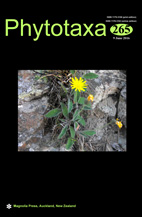Abstract
Parnassia pusilla Wallich ex Arnott (1837: 315) was formally described from plants collected in Gossain-than, actually now Gossain-kund in Nepal (Bhaskar & Shinobu 2012). However, the type number was erroneously cited as Wall. Cat. n. 1255 in the protologue. Later, Hooker and Thomson (1858) corrected it to Wall. Cat. n. 1245. During our recent taxonomic studies on Parnassia Linnaeus (1753: 273) of the Himalaya and adjacent regions (Pan-Himalaya), five herbarium sheets labelled Wallich 1245 kept in E, K and BM were traced, which can be considered as syntypes of the name (see Art. 9.5 and Art. 40. Note 1 of the ICN, McNeill et al. 2012). Among them, the specimen with barcode K000739369, which mounted together on one sheet with two other collections, is mixed. An individual from this specimen marked with “(2)” (Figure 1) should be determined as P. cacuminum Handel-Mazzetti (1931: 433), which is readily distinguished from P. pusilla through the densely purple punctated and erose petals (vs. white and entire petals in P. pusilla). According to Art. 9.11, a lectotype may be designated. Arnott’s herbarium and botanical library were acquired by GL, which is on permanent loan to E (Stafleu & Cowan1976). Stamped with “GL”, the specimen with barcode E00301171 (Figure 2) was better preserved, thus selected as the lectotype in this study.

